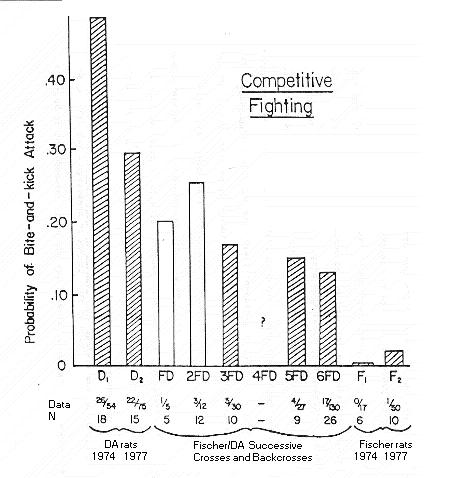Stories
The brain mechanisms of aggression
Motivational systems of social behavior
International Society for Research on Aggression
Behavior Genetics Association Ethics Committee
The World Wide
Runners Club
for Peace
United Nations University for Peace
Charlie Robbins, barefoot runner
* * *
Like scientists in basic physiology, but unlike most scientists doing behavioral research, I used only highly-inbred strains of rats in my experiments. This gave me more control over the variables influencing behavior, as I would usually include more than one strain or hybrid in my experiments differentiate the results as a function of strain.
Hence, in establishing my laboratory at Wesleyan, I did an initial survey of five different highly-inbred strains across various measures of aggressive and related social behaviors to see their differences. I sent the results to the journal Behaviour, but it was rejected and never published. However, the results are available on-line in my materials on the Aggression Systems.
I followed up on the genetic differences by undertaking a long-term study of the genetic structure of competitive fighting using a simple selective breeding design in DA and Fischer rats. Competitive fighting is the offensive fighting (bite-and-kick attack) that occurs between rats when they are hungry and you put only one piece of food in the food hopper that they share. Since the behavior was present in the DA strain, I cross-bred it to produce hybrids with the Fischer strain which did not have competitive fighting. I then tested the hybrids for the behavior, and since the behavior was present I cross the hybrids with the Fischer strain" and keep iterating this procedure for many generations. In that way, if the behavior was determined by one or several tightly-linked genes, the behavior would be retained generation after generation. If the behavior was determined by multiple genes that were not linked during reproduction, the behavior would diminish and gradually disappear over many generations.

In this way we found a single genetic locus (a gene or tightly-linked genes) that determined the difference between two strains, one of which had competitive fighting and the other which did not. I published a brief notes to this effect in the journal Behavior Genetics in 1978 and 1979.
Then I received a phone call from someone identifying himself as being from the United States Air Force and expressing interest to support my research. I was horrified. I realized that if one could isolate the gene and prepare a stable, water-soluable antigen, it could be the basis for a new and terrible military weapon - a cloud that could render a population unable to resist invasion and oppression.
I could not allow myself to be party to the development of such a weapon, so I killed the rats and burned the data and stopped doing research on the genetics of aggression. At about this time I wrote an article on "The Use and Misuse of Aggression Research" for a trade publication, "Multidisciplinary Approaches to Aggression Research. (Elsevier, 1981). I spoke of the question of military research, including secret research, but for obvious reasons did not go into detail about my own experience.
I began to think that the world is not yet ready for science, a belief that has increased over the years, especially in view of the widespread secrecy in science.
 |
Stages
1986-1992
Fall of Soviet Empire
1992-1997
UNESCO Culture of Peace Programme